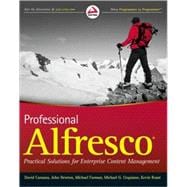
John Newton is the CTO and Chairman for Alfresco Software.
Michael Farman is the Director of Product Management for Alfresco Software.
Michael G. Uzquiano is the Director of Web Platform Tools for Alfresco Software.
Kevin Roast is the User Interface Technical Lead for Alfresco Software.
PART I: GETTING TO KNOW ALFRESCO.
CHAPTER 1: INTRODUCING ALFRESCO.
What Is Enterprise Content Management?
Alfresco Overview.
Content Applications.
Alfresco and Your Environment.
What is Professional Open Source Software?
CHAPTER 2: ARCHITECTURE.
Guiding Principles.
A High-Level Overview.
The Alfresco Content Application Server.
Content Modeling.
The Alfresco Web Application Framework.
Deployment Options.
The Enterprise Infrastructure.
CHAPTER 3: SETTING UP AN ALFRESCO ENVIRONMENT.
Installing Alfresco.
Deploying Extensions.
Debugging Tips.
PART II: GETTING TECHNICAL WITH ALFRESCO.
CHAPTER 4: SERVICES.
Content Repository Services.
Content Application Services.
How Services Are Built.
Using Services.
Content Management Interoperability Services (CMIS).
CHAPTER 5: CONTENT MODELING.
Modeling in Context.
Deploying a Content Model.
The Content Metamodel Explained.
Out-of-the-Box Models.
A Step-by-Step Custom Model.
Creating Content with JavaScript.
Model Localization.
The Relationship to CMIS.
CHAPTER 6: AUTHENTICATION AND SECURITY.
Alfresco Authentication.
Alfresco Security.
Authorities.
Permissions.
Access Control Lists.
Public Services.
Modifying Access Control.
Access Control Extension.
Implementation and Services.
CHAPTER 7: BUSINESS PROCESS MANAGEMENT.
Introduction to Workflow in Alfresco.
Defining a Workflow in Alfresco.
Creating the Process Definition.
The Task Model.
Customizing Behavior.
Configuring the Explorer Web Client.
PART III: EXTENDING ALFRESCO WITH RESTFUL SERVICES.
CHAPTER 8: INTRODUCING WEB SCRIPTS.
Types of Web Scripts.
The Web Script Framework.
Hello World Web Script.
Listing Already-Built Web Scripts.
Where Can I Invoke a Web Script?
Authenticating.
Response Formats.
Anatomy of a Web Script URI.
Working with Client Limitations.
Caching.
CHAPTER 9: HOW TO CREATE A WEB SCRIPT.
Components of a Web Script.
Creating a Description Document.
Creating a Controller Script.
Creating a Response Template.
Registering and Testing.
Multiple Response Templates.
Step-by-Step: Knowledge Base Search Web Script.
Complex Root Objects Reference.
CHAPTER 10: ADVANCED WEB SCRIPTS.
Internationalization.
Configuration.
Content Negotiation.
Multipart Form Processing.
Request Processing.
Caching.
Advanced Descriptor Options.
CHAPTER 11: JAVA-BACKED WEB SCRIPTS.
Step-by-Step: Folder Listing Java-Backed Web Script.
Java Approach to Web Scripts.
Spring-Framework Registration.
Creating a New Kind of Web Script.
PART IV: EXTENDING SHARE.
CHAPTER 12: UNDERSTANDING THE SURF FRAMEWORK.
What Is Surf?.
Basic Concepts.
Putting It into Action.
View Composition.
Presentation Content.
Connectors and Credentials.
Getting Involved.
CHAPTER 13: LEVELS OF CUSTOMIZATION.
Overview.
The Alfresco Repository.
Alfresco Explorer.
Alfresco Share.
CHAPTER 14: CUSTOM KNOWLEDGE BASE: GETTING STARTED.
Installing the Code.
Putting It into Action.
Sample Code.
CHAPTER 15: CUSTOM KNOWLEDGE BASE: BASIC SHARE CUSTOMIZATIONS.
Installing the Code.
Putting It into Action.
CHAPTER 16: CUSTOM KNOWLEDGE BASE: ADVANCED SHARE CUSTOMIZATIONS.
Installing the Code.
Putting It into Action.
CHAPTER 17: INTEGRATING WITH OTHER APPLICATIONS.
Why Integrate Content Management into Applications?
Application Integration Options.
Patterns of Content Management Integration.
Example Integrations.
PART V: APPENDICES (ONLINE ONLY).
APPENDIX A: RESTFUL API REFERENCE.
APPENDIX B: SURF PLATFORM API REFERENCE.
APPENDIX C: REPOSITORY FREEMARKER TEMPLATE API.
APPENDIX D: REPOSITORY JAVASCRIPT API REFERENCE.
APPENDIX E: SURF QUICK REFERENCE.
INDEX.
The New copy of this book will include any supplemental materials advertised. Please check the title of the book to determine if it should include any access cards, study guides, lab manuals, CDs, etc.
The Used, Rental and eBook copies of this book are not guaranteed to include any supplemental materials. Typically, only the book itself is included. This is true even if the title states it includes any access cards, study guides, lab manuals, CDs, etc.